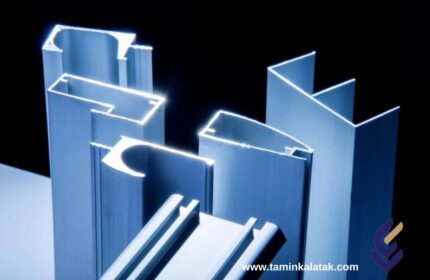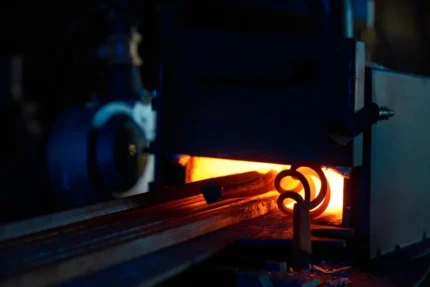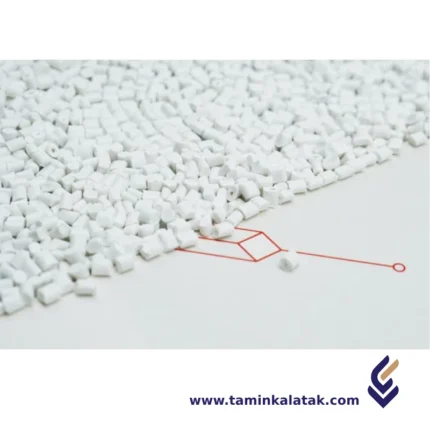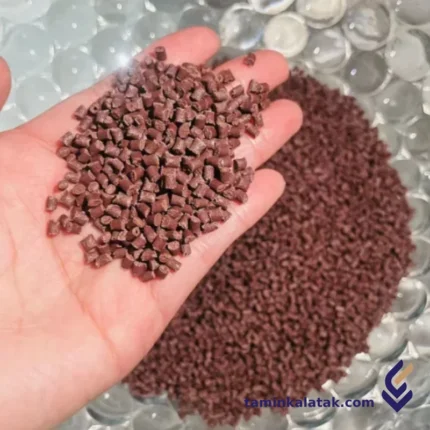Extrusion
The extrusion process is basically designed to continuously convert a soft material into a particular form. The heart of this processing/fabrication machine is a screw conveyer. It carries the cold plastic material (in granular or powdered form) forward by the action of the screw and squeezes it, and, with heat from external heaters and the friction of viscous flow, changes it to a molten stream (refer to Figure 1). As it does this, it develops pressure on the material, which is highest right before the molten plastic enters the die. The screen pack, consisting of a number of fine or coarse mesh gauzes supported on a breaker plate and placed between the screw and the die, filter out dirt and unfused polymer lumps. The pressure on the molten plastic forces it through an adapter and into the die, which dictates the shape of the final extrudate.
Hot extrusionHot extrusion is a hot working process, which means it is done above the material’s recrystallization temperature to keep the material from work hardening and to make it easier to push the material through the die. Most hot extrusions are done on horizontal hydraulic presses that range from 230 to 11,000 metric tons . Pressures range from 30 to 700 MPa , therefore lubrication is required, which can be oil or graphite for lower temperature extrusions, or glass powder for higher temperature extrusions. The biggest disadvantage of this process is its cost for machinery and its upkeep.
Cold extrusionCold Extrusion is a push-through compressive forming process with the starting material (billet/slug) at room temperature. During the process, however, the deforming material undergoes deformation heating (conversion of deformation work to heat) to several hundred degrees. Typically, a punch is used to apply pressure to the billet enclosed, partially or completely, in a stationary die.
Advantages of Extrusion:
- Cost-effective for large-scale production with minimal waste.
- Versatile: Supports various materials and shapes.
- Customizable: Additives and design flexibility.
- Consistent quality and scalable production.
- Energy-efficient and integrates with other processes.
Disadvantages of Extrusion:
- Material limitations: Not all polymers are suitable.
- High setup costs: Equipment and dies are expensive.
- Dimensional variability: Cooling shrinkage and die swell.
- Shape limitations: Intricate designs are challenging.
- Quality control issues: Surface defects and material inconsistencies.
- Post-processing needs: Cutting, finishing, or coating required.
- Environmental concerns: Energy use and plastic waste.
Application of extrusion1.Construction Industry
- Pipes and tubing (e.g., PVC pipes, drainage systems).
- Window and door profiles (e.g., uPVC frames).
- Insulation materials (e.g., foam boards, weather seals).
- Plastic films and sheets (e.g., food packaging, shrink wraps).
- Containers and trays.
- Seals and gaskets.
- Wire and cable insulation.
- Interior trims and protective sheathing.
- Straws, ropes, and garden hoses.
- Plastic profiles for furniture or appliances.
- Wire and cable coatings.
- Conduits for electrical wiring.
- Catheters, tubing, and other medical-grade profiles.
- Conveyor belts and guides.
- Protective linings for machinery.
- Irrigation tubing and films.
- Greenhouse covers.
Film and Sheet Stabilizer
Film and Sheet Stabilizer are essential additives used in the production of plastic films and sheets to enhance their performance and longevity. These additives help to counteract the detrimental effects of heat, light, and oxygen, which can cause degradation and deterioration of the plastic material.
Key Functions of Film and Sheet StabilizersHeat Stabilization: Prevent Thermal Degradation: They inhibit the breakdown of polymer chains at elevated temperatures during processing and subsequent use. Improve Processing Stability: They enhance the flowability of the polymer melt, making processing easier and more efficient. Light Stabilization: Protect Against UV Degradation: They absorb or deflect UV radiation, preventing the polymer chains from breaking down due to photo-oxidation. Maintain Color and Appearance: They help to preserve the original color and prevent discoloration of the film or sheet. Antioxidant Properties: Neutralize Free Radicals: They neutralize free radicals generated during processing and exposure to environmental factors, thus preventing chain scission and degradation. Other Functions: Some stabilizers also provide additional benefits such as improved processability, enhanced mechanical properties, and better resistance to chemicals. Common Types of Film and Sheet Stabilizers: Heat Stabilizers: Calcium-Zinc Stabilizers: Widely used in PVC applications, offering a good balance of performance and cost. Lead Stabilizers: High performance but have environmental and health concerns. Organotin Stabilizers: Excellent heat stability but have environmental and regulatory restrictions. Barium-Zinc Stabilizers: Environmentally friendly alternatives to lead stabilizers. Light Stabilizers: Hindered Amine Light Stabilizers (HALS): Highly effective in preventing photo-oxidation. UV Absorbers: Absorb UV radiation and dissipate it as heat. Antioxidants: Prevent or retard oxidative degradation initiated by heat, light, or other factors.
Applications of Film and Sheet StabilizersPVC Films: Used in packaging, construction, agriculture, and other applications. PE Films: Used in packaging, agriculture, and industrial applications. PP Films: Used in packaging, automotive, and construction. Other Polymers: Used in various other polymers like PET, ABS, etc.
Fitting Stabilizer
Fitting Stabilizer or joint stabilizer is a component used to increase the strength and stability of joints in various systems, especially in the plumbing and construction industries. These components are usually installed at the joints of pipes to valves, fittings, or other equipment to prevent leakage, vibration, and damage to the joints.
Why do we need a fitting stabilizer?Prevent leaks: By creating a tight and sealed connection, it prevents fluid leakage at the joint. Reduce vibration and shock: By absorbing vibrations and forces on the joint, it prevents noise and damage to pipes and joints. Increase the life of joints: By evenly distributing pressure, it prevents local stresses at the joint and increases the life of the joints. Facilitate installation and maintenance: Some stabilizers make installation and maintenance easier.
Fitting Stabilizers ApplicationsPlumbing Industry: Used in water, gas, oil and chemical industry systems to prevent leaks and increase safety. Construction Industry: Used to connect water, gas and sewage pipes in buildings. Automotive Industry: Used in automotive fuel and cooling systems. Aerospace Industry: Used in hydraulic and pneumatic systems of aircraft and spacecraft.
FKM(Fluororubber)
FKM (Fluororubber) is a family of fluorocarbon materials based on fluoroelastomers, defined by ASTM International Standard D1418 and ISO Standard 1629. These materials, commonly known as fluororubber or fluoro-rubber, are highly sought after for their high resistance to heat, chemicals, and environmental factors.
Fluororubber (FKM), also known as Viton, is a high-performance synthetic elastomer known for its exceptional resistance to heat, chemicals, and environmental factors
- Heat Resistance
- Chemical Resistance
- Ozone and UV Resistance
- Low-Temperature Flexibility
- Weathering Resistance
- Low Water Absorption
- High Tensile Strength
Flame Retardant Polypropylene Compounds
Flame Retardant Polypropylene (FR PP) compounds are specially formulated polypropylene materials designed to resist ignition and slow the spread of fire. These compounds are widely used in electrical, automotive, construction, and consumer goods industries where fire safety is crucial.
Structure
Flame Retardant Polypropylene (FR PP) compounds consist of a polypropylene base polymer combined with flame-retardant additives to enhance fire resistance. These additives can be halogenated, such as brominated or chlorinated compounds, or halogen-free, using phosphorus, nitrogen, or inorganic materials like aluminum hydroxide and magnesium hydroxide. The structure of FR PP compounds is carefully designed to balance flame resistance with mechanical properties, ensuring that the material retains its strength, impact resistance, and thermal stability while meeting fire safety standards. In halogenated systems, the flame retardant acts by releasing halogen radicals that interfere with combustion, while in halogen-free formulations, additives promote char formation, cooling effects, or dilution of combustible gases. The polymer matrix and additives must be well-dispersed to maintain processability, allowing the material to be used in various applications such as electrical enclosures, automotive components, and construction materials.Properties
Flame Retardant Polypropylene (FR PP) compounds exhibit a combination of fire resistance, mechanical strength, thermal stability, and processability. These materials are designed to slow down ignition and flame spread, often meeting fire safety standards such as UL 94 V-0 or V-1 ratings. They maintain good impact resistance, stiffness, and durability, making them suitable for demanding applications. Depending on the formulation, halogen-free variants offer low smoke emission and reduced toxicity, making them environmentally friendly. The compounds also have good thermal stability, allowing them to withstand high temperatures without degradation. Additionally, they are easily processable using common manufacturing techniques like injection molding and extrusion, ensuring compatibility with large-scale production. Their balanced properties make them ideal for use in electrical, automotive, construction, and consumer goods industries where fire safety is a priority.Applications
- Electrical and electronics: Cable insulation, connectors, enclosures, circuit breakers.
- Automotive: Battery casings, dashboards, under-the-hood components.
- Building and construction: Pipes, conduits, roofing sheets, insulation panels.
- Consumer goods: Household appliances, furniture, toys, and electronic housings.
- Industrial equipment: Machine housings, safety components, and ventilation systems.
Advantages
- High flame resistance, reducing fire hazards and meeting safety standards.
- Maintains good mechanical properties, including impact strength and stiffness.
- Offers thermal stability for high-temperature applications.
- Halogen-free options provide low smoke emission and reduced toxicity.
- Compatible with standard processing techniques like injection molding and extrusion.
- Lightweight compared to metal alternatives, improving design flexibility.
Disadvantages
- Some formulations may reduce mechanical properties like toughness and elongation.
- Halogenated flame retardants may pose environmental and health concerns.
- Can have higher costs compared to standard polypropylene.
- Certain flame retardant additives may affect recyclability and long-term stability.
- High loading levels of additives in halogen-free variants may impact processability.
Flame Retardants
Flame-retardant finishes are crucial for providing textiles with enhanced safety and performance features. These finishes are not only vital for protecting consumers from the dangers of flammable apparel but also play a significant role in various professional and public safety applications.
Flame retardants are used in a variety of materials and products to increase safety and reduce the risk of fire. They prevent the spread of flame, ensuring the safety of consumers and industrial environments.
Application Flame retardants
- Consumer Apparel
- Firefighting and Emergency Services
- Unsaturated Polyester Resins
- Epoxy Resins
- PVC
Flame-retardant polyamide fiber compounds
Flame-retardant polyamide (PA) fiber compounds are specialized materials designed to resist ignition, reduce flame spread, and minimize smoke production. These compounds are widely used in industries such as automotive, electrical, electronics, and textiles, where fire safety is critical.
Structure
Flame-retardant polyamide fiber compounds are engineered materials that combine polyamide polymers with flame-retardant additives to enhance fire resistance while maintaining mechanical and thermal stability. The base polymer, often PA6 or PA66, provides durability, flexibility, and high melting resistance, while the flame-retardant components are incorporated to inhibit ignition and slow down combustion. These additives can be halogen-based, such as brominated compounds, or halogen-free, including phosphorus, nitrogen, and inorganic fillers like aluminum diethylphosphinate or magnesium hydroxide. The molecular structure of these compounds is designed to promote charring, reduce heat release, and suppress smoke generation. In some formulations, synergists like melamine-based compounds or nanofillers are used to enhance flame-retardant efficiency. The final structure of the compound depends on the type and dispersion of these additives within the polyamide matrix, ensuring a balance between flame resistance, mechanical integrity, and processability for applications in textiles, electronics, and automotive components.
Properties
Flame-retardant polyamide fiber compounds exhibit a combination of thermal stability, mechanical strength, and fire resistance, making them suitable for high-performance applications. These materials are designed to meet stringent fire safety standards, often achieving UL 94 V-0 or V-1 ratings, which indicate their ability to self-extinguish quickly after ignition. They offer low flammability, reduced heat release, and minimal smoke and toxic gas emissions, which are essential for applications in public spaces and enclosed environments. Their mechanical properties, including high tensile strength, flexibility, and abrasion resistance, remain largely unaffected by the incorporation of flame-retardant additives. Additionally, they provide excellent resistance to chemicals, moisture, and heat, making them ideal for demanding environments such as automotive, electrical, and industrial applications. The presence of halogen-free additives, such as phosphorus or nitrogen-based compounds, enhances environmental compatibility while maintaining effective flame retardancy. These properties ensure that flame-retardant polyamide fiber compounds provide both safety and durability without compromising on performance.
Applications
- Automotive: Wire harnesses, connectors, under-the-hood components
- Electronics: Circuit breaker housings, switch components, insulation materials
- Textiles: Protective clothing, carpets, upholstery (aviation, military, public transport)
- Industrial: Conveyor belts, high-performance fabrics, filtration systems
- Excellent flame resistance, meeting UL 94 V-0 or V-1 standards
- High mechanical strength and durability
- Good chemical and thermal resistance
- Low smoke and toxicity emissions, especially in halogen-free formulations
- Suitable for demanding applications requiring both safety and performance
- Higher production costs compared to non-flame-retardant polyamides
- Potential reduction in mechanical properties due to additive incorporation
- Processing challenges, such as increased viscosity and compatibility issues with certain manufacturing techniques
Flap Curing Press & Mould
Lorem ipsum dolor sit amet, consectetur adipiscing elit. Vestibulum sagittis orci ac odio dictum tincidunt. Donec ut metus leo. Class aptent taciti sociosqu ad litora torquent per conubia nostra, per inceptos himenaeos. Sed luctus, dui eu sagittis sodales, nulla nibh sagittis augue, vel porttitor diam enim non metus. Vestibulum aliquam augue neque. Phasellus tincidunt odio eget ullamcorper efficitur. Cras placerat ut turpis pellentesque vulputate. Nam sed consequat tortor. Curabitur finibus sapien dolor. Ut eleifend tellus nec erat pulvinar dignissim. Nam non arcu purus. Vivamus et massa massa.
Flat Belt Curing Press
Lorem ipsum dolor sit amet, consectetur adipiscing elit. Vestibulum sagittis orci ac odio dictum tincidunt. Donec ut metus leo. Class aptent taciti sociosqu ad litora torquent per conubia nostra, per inceptos himenaeos. Sed luctus, dui eu sagittis sodales, nulla nibh sagittis augue, vel porttitor diam enim non metus. Vestibulum aliquam augue neque. Phasellus tincidunt odio eget ullamcorper efficitur. Cras placerat ut turpis pellentesque vulputate. Nam sed consequat tortor. Curabitur finibus sapien dolor. Ut eleifend tellus nec erat pulvinar dignissim. Nam non arcu purus. Vivamus et massa massa.
Flat Belt Drum Vulcanizer
Lorem ipsum dolor sit amet, consectetur adipiscing elit. Vestibulum sagittis orci ac odio dictum tincidunt. Donec ut metus leo. Class aptent taciti sociosqu ad litora torquent per conubia nostra, per inceptos himenaeos. Sed luctus, dui eu sagittis sodales, nulla nibh sagittis augue, vel porttitor diam enim non metus. Vestibulum aliquam augue neque. Phasellus tincidunt odio eget ullamcorper efficitur. Cras placerat ut turpis pellentesque vulputate. Nam sed consequat tortor. Curabitur finibus sapien dolor. Ut eleifend tellus nec erat pulvinar dignissim. Nam non arcu purus. Vivamus et massa massa.
Flat-transmission Belt Machine
Lorem ipsum dolor sit amet, consectetur adipiscing elit. Vestibulum sagittis orci ac odio dictum tincidunt. Donec ut metus leo. Class aptent taciti sociosqu ad litora torquent per conubia nostra, per inceptos himenaeos. Sed luctus, dui eu sagittis sodales, nulla nibh sagittis augue, vel porttitor diam enim non metus. Vestibulum aliquam augue neque. Phasellus tincidunt odio eget ullamcorper efficitur. Cras placerat ut turpis pellentesque vulputate. Nam sed consequat tortor. Curabitur finibus sapien dolor. Ut eleifend tellus nec erat pulvinar dignissim. Nam non arcu purus. Vivamus et massa massa.
Foaming Agents
Foaming agents are crucial chemical additives used in a variety of construction applications to produce foam or air-entrained mixtures. By incorporating air bubbles into concrete, mortar, or other building materials, these agents offer numerous advantages, such as enhanced workability, reduced material density, improved insulation properties, and increased durability.
- Lightweight Concrete
- Insulation
- Tunneling and Mining
- Application Industrial
- Leather
- Flooring and ceiling
- Geotechnical applications











